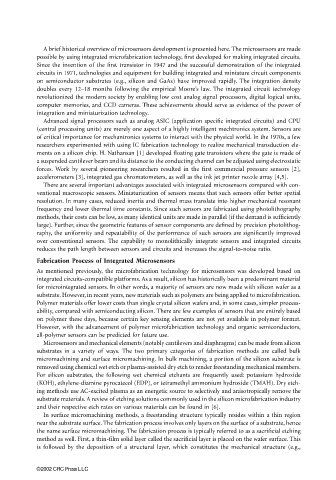Page 515 - The Mechatronics Handbook
P. 515
0066_frame_C19 Page 137 Wednesday, January 9, 2002 5:32 PM
A brief historical overview of microsensors development is presented here. The microsensors are made
possible by using integrated microfabrication technology, first developed for making integrated circuits.
Since the invention of the first transistor in 1947 and the successful demonstration of the integrated
circuits in 1971, technologies and equipment for building integrated and miniature circuit components
on semiconductor substrates (e.g., silicon and GaAs) have improved rapidly. The integration density
doubles every 12–18 months following the empirical Moore’s law. The integrated circuit technology
revolutionized the modern society by enabling low cost analog signal processors, digital logical units,
computer memories, and CCD cameras. These achievements should serve as evidence of the power of
integration and miniaturization technology.
Advanced signal processors such as analog ASIC (application specific integrated circuits) and CPU
(central processing units) are merely one aspect of a highly intelligent mechtronics system. Sensors are
of critical importance for mechantronics systems to interact with the physical world. In the 1970s, a few
researchers experimented with using IC fabrication technology to realize mechanical transduction ele-
ments on a silicon chip. H. Nathansan [1] developed floating gate transistors where the gate is made of
a suspended cantilever beam and its distance to the conducting channel can be adjusted using electrostatic
forces. Work by several pioneering researchers resulted in the first commercial pressure sensors [2],
accelerometers [3], integrated gas chromatometers, as well as the ink jet printer nozzle array [4,5].
There are several important advantages associated with integrated microsensors compared with con-
ventional macroscopic sensors. Miniaturization of sensors means that such sensors offer better spatial
resolution. In many cases, reduced inertia and thermal mass translate into higher mechanical resonant
frequency and lower thermal time constants. Since such sensors are fabricated using photolithography
methods, their costs can be low, as many identical units are made in parallel (if the demand is sufficiently
large). Further, since the geometric features of sensor components are defined by precision photolithog-
raphy, the uniformity and repeatability of the performance of such sensors are significantly improved
over conventional sensors. The capability to monolithically integrate sensors and integrated circuits
reduces the path length between sensors and circuits and increases the signal-to-noise ratio.
Fabrication Process of Integrated Microsensors
As mentioned previously, the microfabrication technology for microsensors was developed based on
integrated circuits-compatible platforms. As a result, silicon has historically been a predominant material
for microintegrated sensors. In other words, a majority of sensors are now made with silicon wafer as a
substrate. However, in recent years, new materials such as polymers are being applied to microfabrication.
Polymer materials offer lower costs than single crystal silicon wafers and, in some cases, simpler process-
ability, compared with semiconducting silicon. There are few examples of sensors that are entirely based
on polymer these days, because certain key sensing elements are not yet available in polymer format.
However, with the advancement of polymer microfabrication technology and organic semiconductors,
all-polymer sensors can be predicted for future use.
Microsensors and mechanical elements (notably cantilevers and diaphragms) can be made from silicon
substrates in a variety of ways. The two primary categories of fabrication methods are called bulk
micromachining and surface micromachining. In bulk machining, a portion of the silicon substrate is
removed using chemical wet etch or plasma-assisted dry etch to render freestanding mechanical members.
For silicon substrates, the following wet chemical etchants are frequently used: potassium hydroxide
(KOH), ethylene-diamine pyrocatecol (EDP), or tetramethyl ammonium hydroxide (TMAH). Dry etch-
ing methods use AC-excited plasma as an energetic source to selectively and anisotropically remove the
substrate materials. A review of etching solutions commonly used in the silicon microfabrication industry
and their respective etch rates on various materials can be found in [6].
In surface micromachining methods, a freestanding structure typically resides within a thin region
near the substrate surface. The fabrication process involves only layers on the surface of a substrate, hence
the name surface micromachining. The fabrication process is typically referred to as a sacrificial etching
method as well. First, a thin-film solid layer called the sacrificial layer is placed on the wafer surface. This
is followed by the deposition of a structural layer, which constitutes the mechanical structure (e.g.,
©2002 CRC Press LLC

